Anencephaly (Q00.0)
A total or partial absence of the brain, together with total or partial absence of the cranial vault and the covering skin

Craniorachischisis(Q00.1)
The presence of anencephaly with a contiguous spine defect without meninges covering the neural tissue (rachischisis).
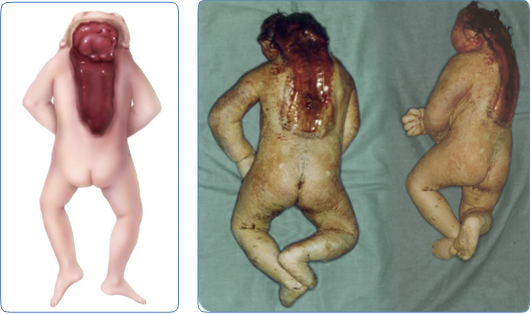
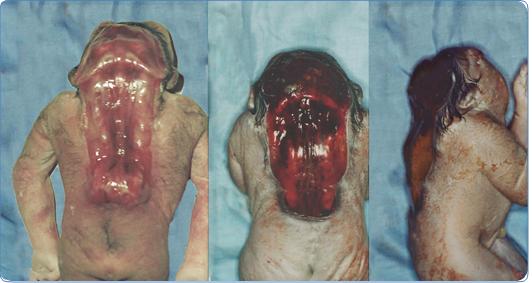
Iniencephaly (Q00.2)
A rare and complex neural tube defect characterized by extreme retroflexion of the head, variably combined with rachischisis of the cervical and thoracic spine and, more rarely, with occipital encephalocele. In iniencephaly, the cranium is always closed.

Frontal encephalocele (Q01.0)
Herniation of brain tissue, usually covered by meninges, through a defect in the frontal bone.

Nasofrontal encephalocele (Q01.1)
Herniation of brain tissue, usually covered by meninges, through an opening between the frontal bone and the nasal and ethmoid bones.
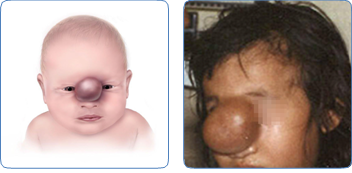
Occipital encephalocele (Q01.2)
Herniation of brain tissue, usually covered by meninges, through an opening in the occipital bone.
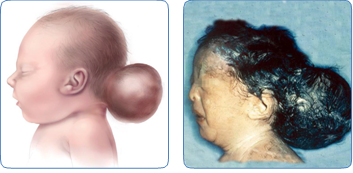
Parietal encephalocele (Q01.80)
Herniation of brain tissue, usually covered by meninges, through an opening in one of the parietal bones.
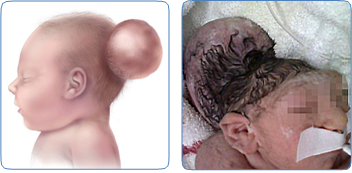
Orbital encephalocele (Q01.81)
Herniation of brain tissue, usually covered by meninges, through one of the orbits.

Nasal encephalocele (Q01.82)
Herniation of brain tissue, usually covered by meninges, through an opening in the nasal region.
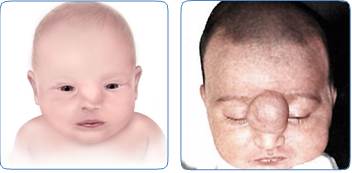
Cervical spina bifida
Most cases of cervical spina bifida will eventually develop hydrocephalus, although this may not be immediately obvious at birth; therefore, coding for cervical spina bifida with or without hydrocephalus could be difficult at birth. Close follow-up of these neonates is important for consideration of shunt surgery.

Cervical spina bifida with hydrocephalus (Q05.0)
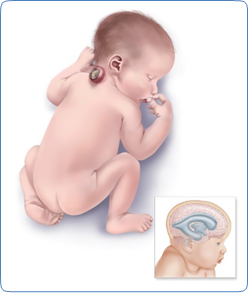 Protrusion of meninges and/or spinal cord through an opening in the cervical region of the spine, associated with hydrocephalus. It may be open, with or without membrane covering; or closed, covered by normal- appearing skin. Hydrocephalus is present as a result of obstruction to the flow of cerebrospinal fluid, secondary to the hindbrain herniation associated with Chiari II malformation.
Protrusion of meninges and/or spinal cord through an opening in the cervical region of the spine, associated with hydrocephalus. It may be open, with or without membrane covering; or closed, covered by normal- appearing skin. Hydrocephalus is present as a result of obstruction to the flow of cerebrospinal fluid, secondary to the hindbrain herniation associated with Chiari II malformation.
Cervical spina bifida without hydrocephalus (Q05.5)
 Protrusion of meninges and/or spinal cord through an opening in the cervical region of the vertebral column. It may be open, with or without membrane covering; or closed, covered by normal-appearing skin.
Protrusion of meninges and/or spinal cord through an opening in the cervical region of the vertebral column. It may be open, with or without membrane covering; or closed, covered by normal-appearing skin.
Thoracic spina bifida
Most cases of thoracic spina bifida will eventually develop hydrocephalus, although this may not be immediately obvious at birth; therefore, coding for thoracic spina bifida with or without hydrocephalus could be difficult at birth. Close follow-up of these neonates is important for consideration of shunt surgery.
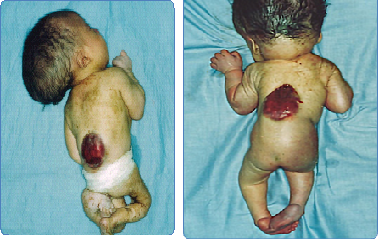
Thoracic spina bifida with hydrocephalus (Q05.1)
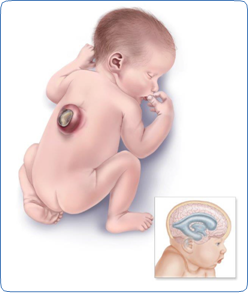 Protrusion of meninges and/or spinal cord through an opening in the thoracic region of the vertebral column, associated with hydrocephalus. It may be open, with or without membrane covering; or closed, covered by normal-appearing skin. Hydrocephalus is present as a result of obstruction to the flow of cerebrospinal fluid, secondary to the hindbrain herniation associated with Chiari II malformation.
Protrusion of meninges and/or spinal cord through an opening in the thoracic region of the vertebral column, associated with hydrocephalus. It may be open, with or without membrane covering; or closed, covered by normal-appearing skin. Hydrocephalus is present as a result of obstruction to the flow of cerebrospinal fluid, secondary to the hindbrain herniation associated with Chiari II malformation.
Thoracic spina bifida without hydrocephalus (Q05.6)
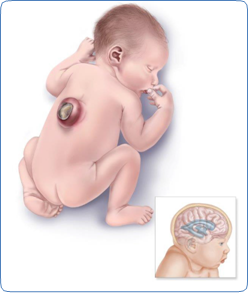 Protrusion of meninges and/or spinal cord through an opening in the thoracic region of the vertebral column, associated with hydrocephalus. It may be open, with or without membrane covering; or closed, covered by normal-appearing skin. Hydrocephalus is present as a result of obstruction to the flow of cerebrospinal fluid, secondary to the hindbrain herniation associated with Chiari II malformation.
Protrusion of meninges and/or spinal cord through an opening in the thoracic region of the vertebral column, associated with hydrocephalus. It may be open, with or without membrane covering; or closed, covered by normal-appearing skin. Hydrocephalus is present as a result of obstruction to the flow of cerebrospinal fluid, secondary to the hindbrain herniation associated with Chiari II malformation.
Lumbar spina bífida
Some cases of lumbar spina bifida will eventually develop hydrocephalus, and this may not be immediately obvious at birth; therefore, coding for lumbar spina bifida with or without hydrocephalus could be difficult at birth. Close follow-up of these neonates is important for consideration of shunt surgery.
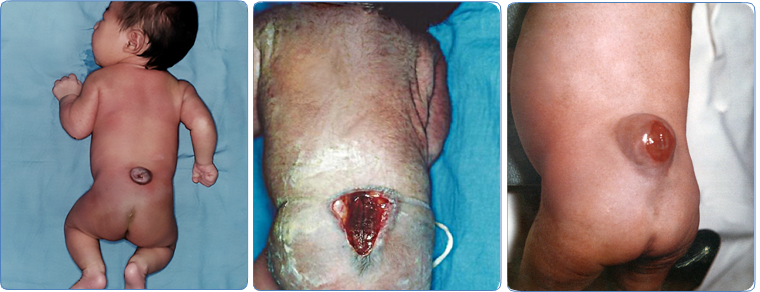
Lumbar spina bifida with hydrocephalus (Q05.2)
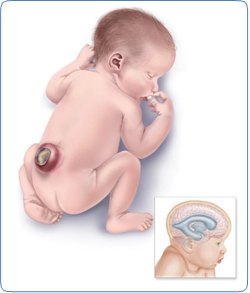 Protrusion of meninges and/or spinal cord through an opening in the thoracic region of the vertebral column, associated with hydrocephalus. It may be open, with or without membrane covering; or closed, covered by normal-appearing skin. Hydrocephalus is present as a result of obstruction to the flow of cerebrospinal fluid, secondary to the hindbrain herniation associated with Chiari II malformation.
Protrusion of meninges and/or spinal cord through an opening in the thoracic region of the vertebral column, associated with hydrocephalus. It may be open, with or without membrane covering; or closed, covered by normal-appearing skin. Hydrocephalus is present as a result of obstruction to the flow of cerebrospinal fluid, secondary to the hindbrain herniation associated with Chiari II malformation.
Lumbar spina bifida without hydrocephalus (Q05.7)
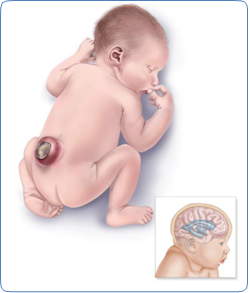 Protrusion of meninges and/or spinal cord through an opening in the thoracic region of the vertebral column, associated with hydrocephalus. It may be open, with or without membrane covering; or closed, covered by normal-appearing skin. Hydrocephalus is present as a result of obstruction to the flow of cerebrospinal fluid, secondary to the hindbrain herniation associated with Chiari II malformation.
Protrusion of meninges and/or spinal cord through an opening in the thoracic region of the vertebral column, associated with hydrocephalus. It may be open, with or without membrane covering; or closed, covered by normal-appearing skin. Hydrocephalus is present as a result of obstruction to the flow of cerebrospinal fluid, secondary to the hindbrain herniation associated with Chiari II malformation.
Sacral spina bifida
Few cases of sacral spina bifida will develop hydrocephalus, compared with the other types of spina bifida. The presence of hydrocephalus in infants with sacral spina bifida may not be immediately obvious at birth; therefore, coding for sacral spina bifida with or without hydrocephalus could be difficult at birth. Close follow-up of these neonates is important for consideration of shunt surgery.
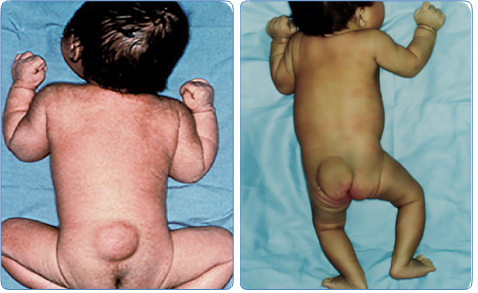
Sacral spina bifida with hydrocephalus (Q05.3)
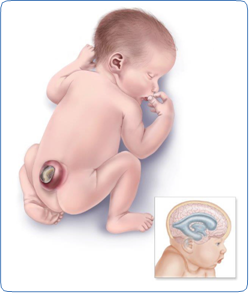 Protrusion of meninges and/or spinal cord through an opening in the sacral region of the vertebral column, associated with hydrocephalus. It may be open, with or without membrane covering; or closed, covered by normal- appearingskin. Hydrocephalus is present as a result of obstruction to the flow of cerebrospinal fluid, secondary to the hindbrain herniation associated with Chiari II malformation.
Protrusion of meninges and/or spinal cord through an opening in the sacral region of the vertebral column, associated with hydrocephalus. It may be open, with or without membrane covering; or closed, covered by normal- appearingskin. Hydrocephalus is present as a result of obstruction to the flow of cerebrospinal fluid, secondary to the hindbrain herniation associated with Chiari II malformation.
Sacral spina bifida without hydrocephalus (Q05.8)
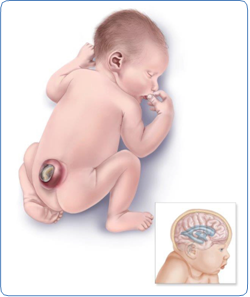 Protrusion of meninges and/or spinal cord through an opening in the sacral region of the vertebral column, associated with hydrocephalus. It may be open, with or without membrane covering; or closed, covered by normal- appearingskin. Hydrocephalus is present as a result of obstruction to the flow of cerebrospinal fluid, secondary to the hindbrain herniation associated with Chiari II malformation.
Protrusion of meninges and/or spinal cord through an opening in the sacral region of the vertebral column, associated with hydrocephalus. It may be open, with or without membrane covering; or closed, covered by normal- appearingskin. Hydrocephalus is present as a result of obstruction to the flow of cerebrospinal fluid, secondary to the hindbrain herniation associated with Chiari II malformation.
Click here for further classification of Congenital Malformations of Nervous System